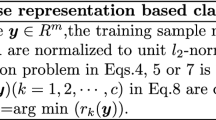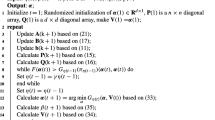Abstract
Sparse representation-based classification (SRC) and its kernel extension methods have shown good classification performance. However, two drawbacks still exist in these classification methods: (1) These methods adopt a \(L_{1}\)-minimization problem to achieve an approximate solution of sparse representation that is originally defined as a \(L_{0}\)-norm optimization problem, which may lead to an increase in the average classification error. (2) These methods employ linear programming, second-order cone programming or unconstrained quadratic programming algorithm to solve the \(L_{1}\)-minimization problem, whose computing time increases rapidly with the number of training samples. In this paper, I incorporate the idea of manifold learning into kernel extension methods of SRC, and propose a novel classification approach, named kernel local sparse representation-based classifier (KLSRC). In the kernel feature space, KLSRC represents a target sample as a linear combination of merely a few nearby training samples, which is called a kernel local sparse representation (KLSR). And then the target sample is assigned to the class that minimizes the residual between itself and the partial KLSR constructed by its training neighbors from this class. Experimental results demonstrate the effectiveness of the proposed classifier.







Similar content being viewed by others
References
Jain AK, Duin PW, Mao JC (2000) Statistical pattern recogniton: a review. IEEE Trans Pattern Anal Mach Intell 22(1):4–37. doi:10.1109/34.824819
Kotsiantis SB (2007) Supervised machine learning: a review of classification techniques. Informatica 31:249–268. doi:10.1007/s10462-007-9052-3
Mller KR, Mika S, Rtsch G, Tsuda K, Schlkopf B (2001) An introduction to kernel-based learning algorithms. IEEE Trans Neural Networks 12(2):181–201. doi:10.1109/72.914517
Taylor JS, Cristianini N (2004) Kernel methods for pattern analysis. Cambridge University Press, Cambridge
Schlkopf B, Smola A, Mller KR (1997) Kernel principal component analysis. In Lecture Notes Comput Sci 1327:583–588. doi:10.1007/BFb0020217
Mika S, Rtsch G, Weston J, Schlkopf B, Mller KR (1999) Fisher discriminant analysis with kernels. In IEEE Signal Processing Society Workshop on Neural Networks for Signal Processing IX, 41–48. doi:10.1109/NNSP.1999.788121
Yu K, Ji L, Zhang XG (2002) Kernel nearest-neighbor algorithm. Neural Process Lett 15(2):147–156. doi:10.1023/A:1015244902967
Wright J, Yang AY, Ganesh A, Sastry SS, Ma Y (2009) Robust face recognition via sparse representation. IEEE Trans Pattern Anal Mach Intell 31(2):210–227. doi:10.1109/TPAMI.2008.79
Zhang L, Zhou WD, Chang PC, Liu J, Yan Z, Wang T, Li FZ (2012) Kernel sparse representation-based classifier. IEEE Trans Signal Process 60(4):1684–1695. doi:10.1109/TSP.2011.2179539
Yin J, Liu ZH, Jin Z, Yang WK (2012) Kernel sparse representation based classification. Neurocomputing 77:120–128. doi:10.1016/j.neucom.2011.08.018
Jian M, Jung C (2013) Class-discriminative kernel sparse representation-based classification using multi-objective optimization. IEEE Trans Signal Process 61(18):4416–4427. doi:10.1109/TSP.2013.2271479
Roweis ST, Saul LK (2000) Nonlinear dimensionality reduction by locally linear embedding. Science 290:2323–2326. doi:10.1126/science.290.5500.2323
He XF, Yan SC, Hu YX, Niyogi P, Zhang HJ (2005) Face recognition using Laplacian faces. IEEE Trans Pattern Anal Mach Intell 27(3):328–340. doi:10.1109/TPAMI.2005.55
Wang RP, Chen XL (2009) Manifold discriminant analysis. In IEEE Conf Computer Vision and Pattern Recognition (CVPR), 429–436, doi:10.1109/CVPR.2009.5206850
Martinez AM, Benavente R (1998) The AR face database. CVC Technical Report #24
Murase H, Nayar SK (1995) Visual learning and recognition of 3d objects from appearance. Int J Comput Vis 14(1):5–24. doi:10.1007/BF01421486
Mizukami Y, Tadamura K, Warrell J, Li P, Prince S (2010) CUDA implementation of deformable pattern recognition and its application to MNIST handwritten digit database. In Int Conf Pattern Recognition (ICPR), 2001–2004, doi: 10.1109/ICPR.2010.493
Zhang D, Kong WK, You J, Wong M (2003) Online palmprint identification. IEEE Trans Pattern Anal Mach Intell 25(9):1041–1150. doi:10.1109/TPAMI.2003.1227981
Belhumeur PN, Hepanha JP, Kriegman DJ (1997) Eigenfaces vs. fisherfaces: recognition using class specific linear projection. IEEE Trans Pattern Anal Mach Intell 19(7):711–720. doi:10.1007/BFb0015522
Acknowledgments
This work is partially supported by A Project Funded by the Priority Academic Program Development of Jiangsu Higher Education Institutions.
Author information
Authors and Affiliations
Corresponding author
Rights and permissions
About this article
Cite this article
Liu, Q. Kernel Local Sparse Representation Based Classifier. Neural Process Lett 43, 85–95 (2016). https://doi.org/10.1007/s11063-014-9403-4
Published:
Issue Date:
DOI: https://doi.org/10.1007/s11063-014-9403-4




